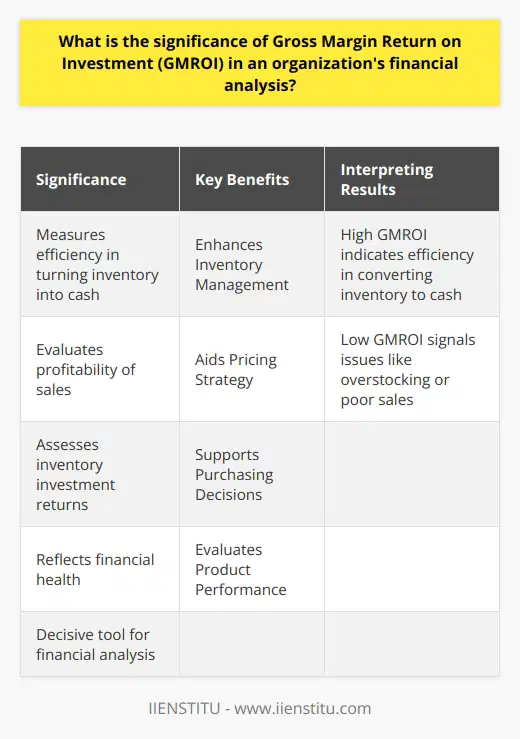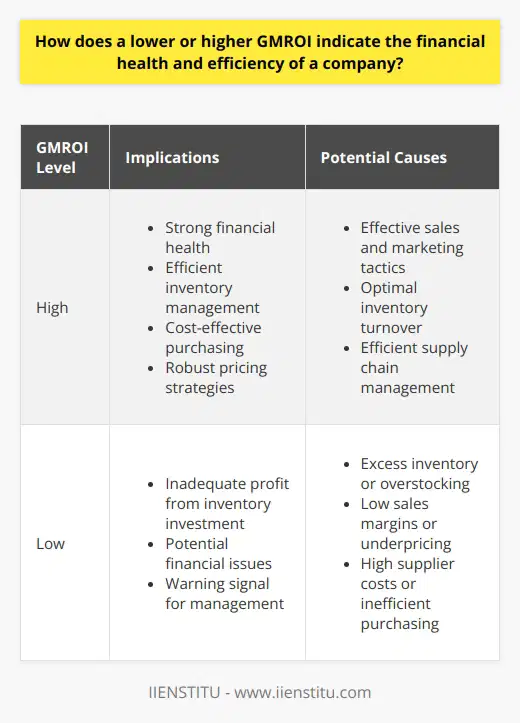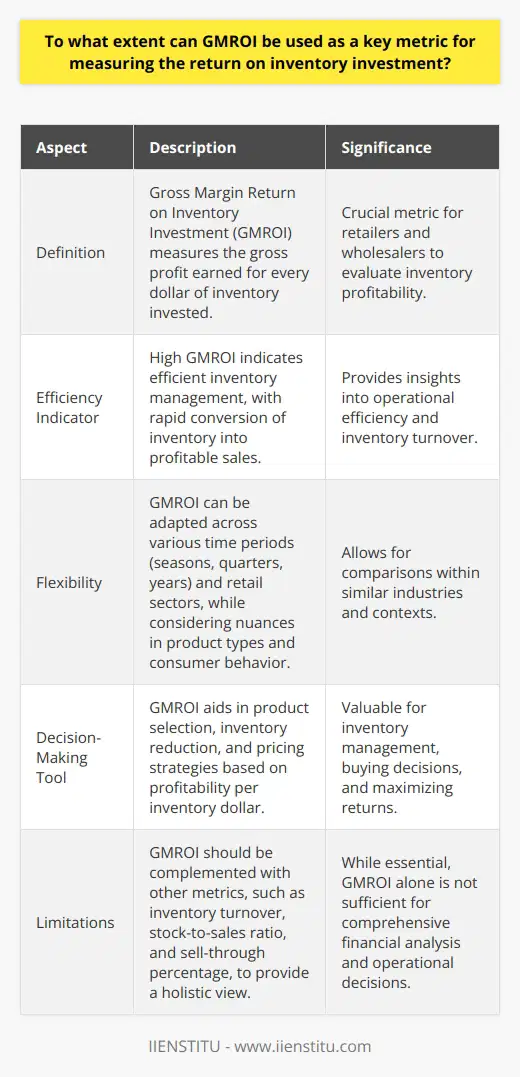
In the intricate world of business analysis and investment, the metric known as Gross Margin Return on Investment (GMROI) stands out as a pivotal instrument. It provides a clear-cut perspective on how effectively a company is turning its inventory into cash over and above the cost of the inventory itself. As we delve deeper into the intricacies of GMROI, we find that it goes beyond mere figures and instead paints a realistic picture, showcasing the critical balance between profitability and inventory management.
Such a balance is especially crucial for businesses and investors who strive to make informed decisions that shape the economic landscape. The importance and significance of GMROI cannot be overstated, as it actively influences strategies, operational tactics, and long-term planning.
Understanding GMROI—Concept and Calculation
Explanation of Gross Margin
The financial health of a business is often encapsulated in its Gross Margin – a key indicator of profitability. It represents the difference between sales revenue and the cost of goods sold (COGS), expressed as a percentage of sales. Gross Margin is the pulse that helps in determining the financial viability and efficiency of a company's core activities.
To calculate Gross Margin, one must subtract COGS from total sales revenue and then divide by total sales revenue. This result, multiplied by 100, gives us the percentage that constitutes the gross margin, and it serves as the foundational element in understanding the resourcefulness of operational efficiency.
Understanding Return on Investment (ROI)
As an indispensable yardstick in financial analysis, ROI measures the gain or loss generated on an investment relative to the amount of money invested. It is a universal benchmark that allows for the comparison of the efficiency of several different investments. To ascertain the ROI, one must divide the net profit by the initial cost of the investment.
The result expressed as a percentage reflects not just the profitability but provides a lens to gauge the effectiveness of investment decisions. As such, it carries with it the expectations and realities of financial success or failure within any business venture.
Defining Gross Margin Return on Investment
GMROI is the confluence of Gross Margin and ROI, offering a composite view that assesses inventory profitability. A simple yet profound equation, GMROI is calculated by dividing the Gross Margin by the Average Inventory Cost. Essentially, this metric indicates how many dollars of gross margin are earned for every dollar of inventory investment made, intertwining the concepts of profit generation and efficient asset utilization.
Through this unification, GMROI emerges not only as a yardstick of success but as a strategic tool for future planning.
Offering an easy-to-understand example for GMROI calculation
Consider a retailer who achieves a gross margin of $150,000, with the average inventory cost amounting to $50,000. By dividing the gross margin by the average inventory cost, the GMROI can be determined. In this case, $150,000 divided by $50,000 equals 3.
This result means that for every dollar invested in inventory, the retailer earns three dollars in gross profit, showcasing the efficiency of inventory investment in relation to profit generation.
Significance of GMROI in Business and Investment Decisions
Role of GMROI in inventory management
In retail and wholesale, GMROI is an invaluable metric for evaluating not just the profitability of specific items, but also the effectiveness of inventory management practices. By pinpointing how well an inventory investment is paying off, businesses gain a clearer understanding of their inventory dynamics.
This insight becomes pivotal when deciding which items to stock more abundantly and which to discontinue, enabling savvy inventory stocking decisions that optimize both space and financial resources.
Use of GMROI in evaluating business performance
GMROI is also indispensable for painting a broader picture of a company's profitability landscape. Different product lines can be assessed to illuminate which are contributing the most to the company's bottom line, providing a breakdown of performance that can guide strategic adjustments.
Furthermore, by identifying areas of improvement within the business, such as product offering or pricing strategies, companies can tailor enhancements to fortify their market position.
Applications of GMROI in investment decisions
Among investors, GMROI serves as a crucial indicator, assisting in the methodical evaluation of company health and potential. Its role is particularly significant when comparing investment opportunities across a diverse portfolio.
As investors aim to maximize their returns, GMROI provides the lens to discern not only which companies exhibit superior inventory turnover but also showcases those that effectively convert inventory into substantial profits.
Advantages and Limitations of GMROI
Advantages of using GMROI as a performance measure
GMROI stands as a beacon of efficiency in streamlining inventory management, allowing firms to gauge the impact of inventory on profitability tactically. Additionally, this measure offers a profound understanding of the interplay between sales and inventory, revealing insights into business profitability that can shape decision-making processes. This level of analysis is crucial for sustaining growth and maintaining a competitive edge in today's cutthroat market environment.
Limitations and potential issues with GMROI utilization
However, GMROI is not without its limitations. It does not account for the nuances of overstocking and understocking nor does it incorporate other key assets in the evaluation of overall business health. Moreover, GMROI fails to reckon with the dynamic, temporal aspects of the business such as seasonal trends and market fluctuations which can significantly influence inventory turnover and profitability.
In sum, GMROI emerges as an essential, though not infallible, tool in the vast arsenal of financial metrics. It provides a sharp snapshot of the impact of inventory investment on profitability yet should be wielded with an awareness of its constraints. As businesses and investors navigate the complex currents of economic decision-making, adopting a comprehensive approach that integrates GMROI alongside other analytical tools will pave the way toward more astute and lucrative strategies. By reifying the importance of GMROI and leveraging it judiciously, organizations can illuminate the path to enhanced profitability and long-term success.
Frequently Asked Questions
What is the significance of Gross Margin Return on Investment (GMROI) in an organization's financial analysis?
Understanding GMROI
Gross Margin Return on Investment, or GMROI, measures efficiency. It evaluates how a company turns inventory into cash. Specifically, GMROI looks at the gross margin. This reveals the profitability of the company's sales.
Significance in Financial Analysis
GMROI acts as a decisive tool. It empowers companies to assess inventory investment returns. Higher GMROI values suggest better inventory efficiency. Companies strive for improving their GMROI. It reflects on sound financial health.
Key Benefits of GMROI
Enhances Inventory Management
Effective inventory management is crucial. GMROI gives insights into inventory performance. It allows firms to identify unprofitable inventories. They can then make informed decisions about stock levels.
Aids Pricing Strategy
Pricing greatly affects gross margin. GMROI helps determine if prices align with inventory costs. Adjustments can thus optimize profitability.
Supports Purchasing Decisions
GMROI influences purchasing. It signals whether to increase or decrease investment. Firms can align purchases with financial goals, thanks to GMROI data.
Evaluates Product Performance
Not all products perform equally. GMROI identifies high and low performers. Firms can focus on profitable items and discard weak ones.
Interpreting GMROI Results
High GMROI
A high GMROI indicates efficiency. It shows firms turn inventory into cash well.
Low GMROI
On the contrary, a low GMROI signals issues. It points to potential overstocking or poor sales.
Conclusion
GMROI serves as a compass. It guides financial strategies and decisions. It underscores the importance of inventory in financial success. Smart use of GMROI can yield better financial outcomes. Companies rely on it for comprehensive financial analysis.

How does a lower or higher GMROI indicate the financial health and efficiency of a company?
Understanding GMROI
GMROI stands for Gross Margin Return on Investment. It measures a company's financial efficiency. Specifically, it assesses inventory investment returns. Financial analysts and retail managers often use GMROI. It helps in guiding pricing, purchasing, and sales decisions.
Significance of GMROI in Financial Health
GMROI demonstrates profitability and inventory management. A higher GMROI indicates more efficient inventory use. In contrast, a lower GMROI signifies potential issues. These may involve overstocking or underpricing.
High GMROI: A Sign of Strength
A high GMROI implies strong financial health. It suggests efficient inventory management and cost-effective purchasing. A higher GMROI also points to robust pricing strategies. It ensures inventory generates substantial profit.
Low GMROI: A Warning Signal
A low GMROI demands attention. It reflects inadequate profit from inventory investment. Potential causes include excess inventory or low sales margins. Companies need to investigate these indicators. Lower GMROI also highlights pricing or supplier cost issues.
GMROI and Company Efficiency
- GMROI measures return on inventory investment.
- It gauges inventory-related financial performance.
- High values indicate strong sales or low costs.
- Low values may reveal excess inventory or high costs.
Improving GMROI
Businesses aim to optimize their GMROI. Strategies involve pricing adjustments and cost controls. Inventory turnover is a vital focus area. Efficient sales and marketing tactics also contribute.
Conclusion
GMROI reveals much about a company's efficiency. Higher GMROI is a goal for sound financial management. Yet, one must interpret GMROI within broader business contexts. Market conditions, business cycles, and consumer trends can all affect GMROI. Thus, executives should monitor and adjust strategies to maintain a favorable GMROI.

To what extent can GMROI be used as a key metric for measuring the return on inventory investment?
Understanding GMROI
Gross Margin Return on Inventory Investment (GMROI) is a crucial metric. Retailers and wholesalers often use it. It measures how much gross profit a company earns. Every dollar of inventory invested yields this profit.
A Key Indicator of Efficiency
GMROI is particularly telling, representing inventory profitability. It combines margin and turnover into one figure. Companies gain insight into their operations through this metric. High GMROI indicates efficient management. It means inventory quickly converts into sales. And those sales are profitable.
Profits play into inventory investment strategies. They highlight the balance between sales and inventory levels. GMROI helps in achieving this balance.
Flexibility and Coverage
The metric offers flexibility. It is adaptable across various periods. This includes seasons, quarters, or years. Retail sectors use it with no issue. Differences in product types and consumer behavior create nuance here.
Every industry can apply GMROI to some extent. But one must consider the context. Comparisons are only meaningful within similar sectors.
Advantageous for Decision Making
Inventory decisions utilize GMROI heavily. It aids in selecting which products to stock. Profitability per inventory dollar is the focus. Retailers benefit from this the most.
It also assists in inventory reduction. Low GMROI items may suggest poor performance. Retailers could reconsider these items.
Limitations and Complementary Metrics
GMROI is not the sole deciding factor. It does have limitations. Inventory decisions need holistic information. Other metrics complement GMROI effectively. These include:
- Inventory turnover
- Stock to sales ratio
- Sell-through percentage
Insight improves when one combines these metrics. Broader operational decisions rely on diverse data.
The Extent of GMROI as a Measurement Tool
GMROI serves as a significant indicator in retail. It measures the return on inventory investment precisely. Nevertheless, it cannot stand alone. Managers must look beyond GMROI for complete analysis. It forms part of a toolkit for financial performance.
GMROI influences buying, pricing, and markdown strategies. It is a key metric. But it requires context and supplementing with other data for the best decisions. Thus, GMROI is essential but not exclusive in inventory management.



